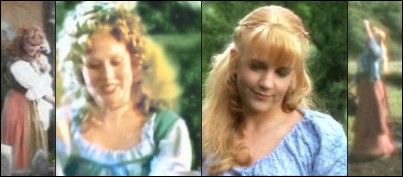
Throughout the trilogy of films masterminded by WingNut Films, homages are made to an array of sources in order to inspire certain feelings in the audience and to pay tribute to earlier pieces of art. Many of these are known to fans already, such as Sam's use of a frypan as a weapon as a reference to Sean Astin's earlier role in Toy Soldiers, or the shots of the Uruk Hai armies as an echo of Leni Riefenstahl's Nazi documentaries.
There are many other instances, less readily identifiable, and the images of Rosie in the first and last films of trilogy are examples of this.
Sam and Rosie's wedding:


Rosie's fair curls and garland of flowers are like those of the lead character in the episode The Three Ravens from the television show The Storyteller, made in 1987. There is evidence enough on this page here that this particular episode has more than likely been seen and appreciated by someone closely involved in the cinematography of The Lord of the Rings.
"Well, I'm back." :


The shot of Rosie and baby Frodo in front of the door to the Gamgee smial is reminiscent of Helen Allingham's famous watercolours of victorian cottages. Helen Allingham lived from 1848 to 1926, and her paintings have become synonymous with bucolic tranquility and rural family life. Below are thumbnailed links to a selection of other Allingham images illustrating the 'mother and child by the door' motif.






Ngila Dickson, who designed the costumes for the Lord of the Rings trilogy, also worked on Xena: Warrior Princess, through the second half of the nineteen-nineties until 2001.

Gabrielle, Xena's bardic offsider, began the show in a farm-girl outfit of a blue blouse and a two-layered skirt like that worn by Rosie at Bilbo's party (Gabrielle's two-layered skirt, however, was an orange colour, like that of Rosie's skirt in the Return of the King), with a jacket in a deeper shade of blue sometimes added to the outfit (Rosie and Frodo are the only hobbits to wear blue, and both wear it in more than one shade at once).
In a later season, Gabrielle pairs an orange skirt with a green top, the same colour combination as Rosie's costume at the end of the Return of the King.
Does this mean anything except that the webmistress of this site is in dire need of help and/or a life? No. But there you go.

In the top right and bottom left corner of this image are engravings by Thomas Cheesman (1760-1835), based on artworks by Domenichino (1581-1641) and representing 'winter' and 'summer' respectively. The top left still is from the scene in Return of the King where Gondorian soldiers are sent on what is, essentially, a suicide mission. Many of the townspeople who watch them leave are dressed in the style of Domenichino's figures, with their heads covered by fabric. The architecture of Minas Tirith is also drawn from this school of art. The fact that these particular images are not Domenichino originals but rather reinterpretations by Cheeseman, a Victorian-era artist, adds another layer of meaning again; an analysis of Tolkien's hobbits, and the Shire, in relation to that period of history would be a long and complicated discussion indeed.
The two children are Billy and Katie Jackson, children of director Peter Jackson and writer Fran Walsh. The Jackson children appear in all three films as cameo extras, but in Return of the King they show up twice - once in Gondor, in one of the darkest moments of the film, and then again in Sam and Rosie's wedding party. This wedding is where the lower righthand shot comes from, with Rosie's golden hair and garland of flowers very like the 'summer' half of the diptych.
|
|
|